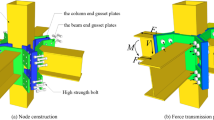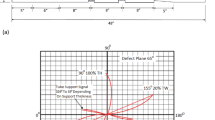Abstract
In a wind energy system, the safety and stability of substructures plays an important role during the in service of offshore structure. Offshore structures are continuously subjected to high cyclic fatigue loads and may experience fatigue cracks due to the continuous accumulation of plastic strain and stress concentrations at welded joints. The fatigue life of welded tubular joints is one of the most important factors determining the life of offshore structures. In this study, the fatigue analysis of tubular joints of the tripod and jacket support structure was performed using 3D fatigue FEM to estimate the fatigue life and predict the positions of crack initiation. The 3D fatigue FE is based on constitutive equations and continuum damage mechanics. The welding state of tubular joints were reproduced to calculate the welding residual stresses and welding deformation. The residual stresses and weld deformation were used as input together with cyclic loading in the 3D fatigue FE to calculate the fatigue life and predict the crack initiation positions. The S-N curve calculated by the 3D fatigue FE analysis were compared with the SN curves of Eurocode 3. The results show that 3D fatigue FE analysis is an effective tool to analyze large and complex structures before installation to ensure the safety and stability of the structure.
Similar content being viewed by others
Abbreviations
- A n :
-
Amplitude of octahedral shear Stress
- c :
-
Specific heat
- D :
-
Damage variable
- D N :
-
Damage value at Nth cycle
- k :
-
Thermal conductivity
- N :
-
Number of cycles
- N :
-
Number of cycles to failure
- Q :
-
Rate of moving heat generation per unit volume
- Q A :
-
Heat input from the welding arc
- Q, b :
-
Material constants in isotropic hardening rate function
- R :
-
Isotropic hardening rate
- ro :
-
Arc beam radius
- X Dij :
-
Back stress increment tensor
- α, β :
-
Material constants of damage
- ∇:
-
Spatial gradient operator
- ΔD :
-
Increment of damage evolution
- δN :
-
Increment of the number of cycles
- \(\overline{\sigma}\) :
-
effective stress tensor
- dε ij :
-
Total strain increment
- dε pij :
-
Elastic strain increment
- dε pij :
-
Plastic strain increment
- dε thij :
-
Thermal strain increment
- γ k, c k :
-
Material constants in kinematic hardening
- σ eq :
-
Equivalent of von Mises stress
- σ ij :
-
Stress tensor
- σ m :
-
Mean stress
- σ max :
-
Maximum stress
- ρ :
-
Density
References
Afandi AA, Muis Alie MZ (2020) Fatigue life Prediction on jacket leg structure subjected to axial and wave loads. IOP Conf. Series: Earth and Environmental Science 575:012194, DOI: https://doi.org/10.1088/1755-1315/575/1/012194
Ashuri T, Zaaijer MB (2007) Review of design concepts, methods, and considerations of offshore wind turbines. European Offshore Wind conference and exhibition, Berlin., Dec.
Chaboche JL, Lesne PM (1998) A non-linear continuous fatigue damage model. Fatigue & Fracture of Engineering Materials & Structures 11:1–17, DOI: https://doi.org/10.1111/j.1460-2695.1988.tb01216.x
Chang KH, Lee CH (2006) Characteristics of high-temperature tensile properties and residual stresses in weldments of high strength steels. Materials Transactions 47:348–354, DOI: https://doi.org/10.2320/matertrans.47.348
Chang KH, Lee CH, Park K, Um TH (2011) Experimental and numerical investigation on residual stresses in a multi-pass butt-welded high strength SM570-TMCP steel plate. International Journal of Steel Structures 11:315–324, DOI: https://doi.org/10.1007/s13296-011-3006-y
Chella AM, Torum A, Dag M (2012) An overview of wave impact forces on offshore wind turbine substructures. Energy Procedia 20:217–226, DOI: https://doi.org/10.1016/j.egypro.2012.03.022
Chew KH, Muskulus M, Zwick D, Ng EYK, Tai K (2013) Structural optimization and parametric study of offshore wind turbine jacket substructure. Proceedings of the International Offshore and Polar Engineering Conference, ISSN 1098-6189
Chew K-H, Ng E, Tai K (2014) Offshore wind turbine jacket substructure: A comparison study between four-legged and three-legged designs. Journal of Ocean and Wind Energy (ISSN2310-3604) 2:74–81, https://hdl.handle.net/10356/100546
Dong W, Moan T, Gao Z (2012) Fatigue reliability analysis of the jacket support structure for offshore wind turbine considering the effect of corrosion and inspection. Reliability Engineering & System Safety 106:11–27, DOI: https://doi.org/10.1016/j.ress.2012.06.011
Hao E, Liu C (2017) Evaluation and comparison of anti-impact performance to offshore wind turbine foundations: Monopile, tripod, and jacket. Ocean Engineering 130:218–227, DOI: https://doi.org/10.1016/j.oceaneng.2016.12.008
Henderson A, Zaaijer M, Camp T (2003) Hydrodynamic Loading of Offshore Wind Turbines. OWEMES Conference, Naples
Jang GB, Chang KH (2008) A rate-independent hysteresis model for structural steel (SM490) considering the coupled effect of strain rate hardening and temperature rise. Materials Science Forum 580–582, DOI: MSF.580-582.581
Kharade AS, Kapadiya SV (2014) Offshore engineering: An overview of types and loadings on structure. International Journal of Structural and Civil Engineering Research 2(3), ISSN 2319-6009
Larsen CE (1991) Predicting the fatigue life of offshore structures by the single-moment spectral method. Probabilistic Engineering Mechanics 6(20):96–108, DOI: https://doi.org/10.1016/0266-8920(91)90023-W
Lemaitre J (1985) A continuous damage mechanics model for ductile fracture. Journal of Engineering Materials and Technology 107:83–89, DOI: https://doi.org/10.1115/1.3225775
Mai QA, Weijtjens W, Devriendt C, Morato PG, Rigo P, Sorensen JD (2019) Prediction of remaining fatigue life of welded joints in wind turbine support structures considering strain measurement and joint distribution of oceanographic data. Marine Structures 66:307–322, DOI: https://doi.org/10.1016/j.marstruc.2019.05.002
Mendes P, Correia Jose AFO, Mourao A, Pereira R, Fantuzzi N, De jesus A, Calcada R (2021) Fatigue assessment of a jacket-type offshore structure based on static and dynamic analysis. Practical Periodical on Structural Design and Construction 26:04020054–13, DOI: https://doi.org/10.1061/%28ASCE%29SC.1943-5576.0000533
Muzaffer S, Chang KH, Wang ZM, Kang SU (2022) Comparison of stiffener effect on fatigue crack in KT-type pipe joint by FEA. Weld World 66:783–797, DOI: https://doi.org/10.1007/s40194-022-01254-z
Nabuco B, Tarpo M, Tygesen UT, Brinker R (2020) Fatigue stress estimation of an offshore jacket structure based on operational modal analysis. Shock and Vibration, Article ID: 7890247, DOI: https://doi.org/10.1155/2020/7890247
Oh KY, Nam W, Ryu MS, Kim JY, Epureanu BI (2018) A review of foundations of offshore wind energy converters: Current status and future perspectives. Renewable and Sustainable Energy Reviews 88:16–36
Plodpradit P, Dinh VN, Kim K-D (2019) Tripod-supported offshore wind turbines: Modal and coupled analysis and a parametric study using X-SEA and FAST. Journal of Marine Science and Engineering 7(6):181, DOI: https://doi.org/10.3390/jmse7060181
Sadeghi K (2007) An overview of design, analysis, construction, and installation of offshore petroleum platforms suitable for Cyprus Oil/gas fields. International Journal of Steel Structures 2(4):1–16
Shin WS, Chang KH, Shazia M (2021) Fatigue analysis of cruciform welded joints with weld penetration defects. Engineering Failure Analysis 120, DOI: https://doi.org/10.1016/j.engfailanal.2020.105111
Stahlmann A, Schlurmann T (2010) Physical modeling of scour around tripod foundation structures for offshore wind energy. Coastal Engineering 1(32), DOI: https://doi.org/10.9753/icce.v32.sediment.67
Vuong NVD, Lee CH, Chang KH (2015a) A constitutive model for uniaxial/multiaxial ratcheting behavior of duplex stainless steel. Materials & Design 65:1161–1171, DOI: https://doi.org/10.1016/j.matdes.2014.08.046
Vuong NVD, Lee CH, Chang KH (2015b) High cycle fatigue analysis in presence of residual stresses by using a continuum damage mechanics model. International Journal of Fatigue 70:51–62, DOI: https://doi.org/10.1016/j.ijfatigue.2014.08.013
Yang H-Z, Zhu Y, Lu Q, Zhang J (2015) Dynamic reliability-based design optimization of the tripod sub-structure of offshore wind turbines. Renewable Energy 78:16–25, DOI: https://doi.org/10.1016/j.renene.2014.12.061
Yeter B, Garbatov Y, Soares CG (2016) Evaluation of fatigue damage model predictions for fixed offshore wind turbine support structures. International Journal of Fatigue 87:71–80, DOI: https://doi.org/10.1016/j.ijfatigue.2016.01.007
Zaaijer MB (2003) Comparison of monopile, tripod, suction bucket, and gravity base design for a 6-MW turbine. Offshore Wind energy in Mediterranean and Other European Seas (OWEMES conference), Naples, Italy, April 2003
Zhang L, Liu X, Wang L, Wu S, Fang H (2012) A model of continuum damage mechanics for high cycle fatigue of metallic materials. Transactions of Nonferrous Metals Society of China 22:2777–2782, DOI: https://doi.org/10.1016/S1003-6326(11)61532-X
Acknowledgments
This research was supported by the Basic Science Research Program through the National Research Foundation of Korea (NRF) funded by the Ministry of Education (NRF-2021R111A204584511). This research was also supported by Chung-Ang University research grants in 2018.
Author information
Authors and Affiliations
Corresponding author
Rights and permissions
About this article
Cite this article
Muzaffer, S., Chang, KH. & Hirohata, M. Fatigue Life Comparison of Tubular Joints in Tripod and Jacket Offshore Support Substructures Using 3D Fatigue FE Analysis. KSCE J Civ Eng 28, 849–859 (2024). https://doi.org/10.1007/s12205-023-1043-7
Received:
Accepted:
Published:
Issue Date:
DOI: https://doi.org/10.1007/s12205-023-1043-7




